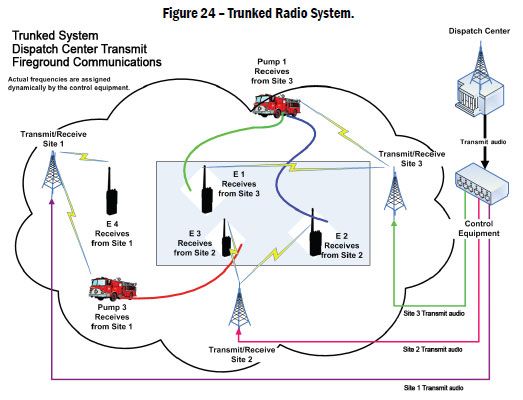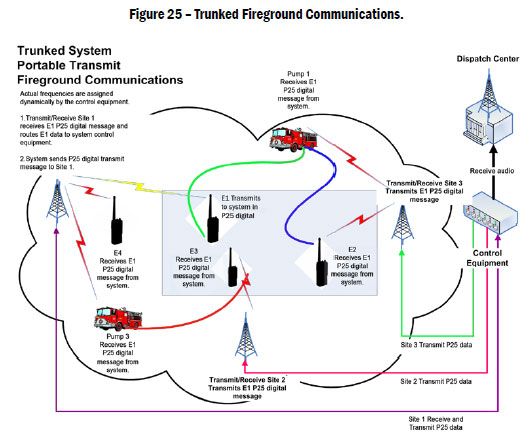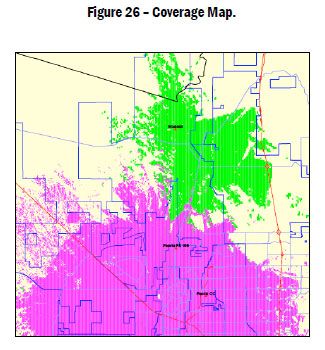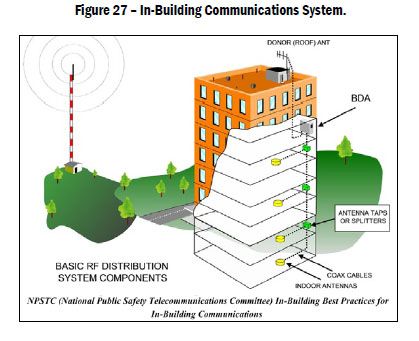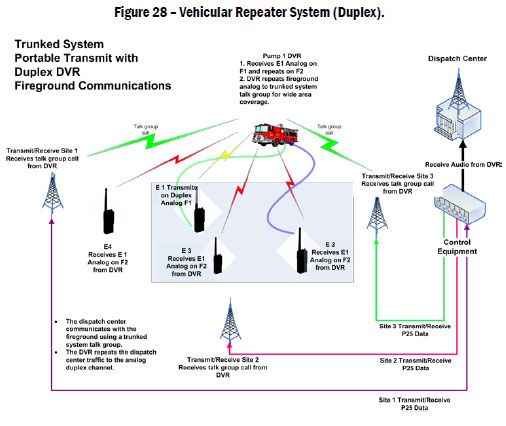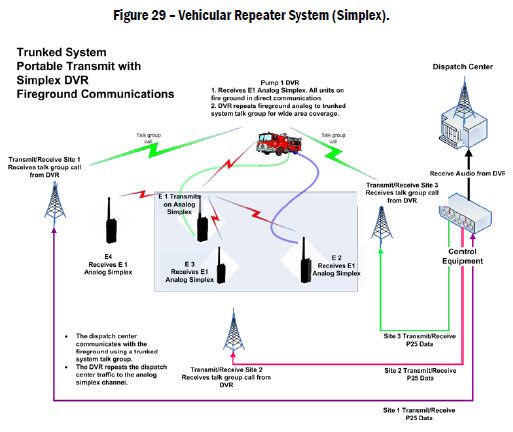| Editor’s note: The IAFF and the USFA released an updated version of its Voice Radio Communications Guide for the Fire Service in Oct. 2008. The guide focuses on seven sections of communications – basic radio communication technology, radios and radio systems, portable radio selection and use, trunked radio systems, system design and implementation, interoperability, and radio spectrum licensing and the federal communications commission. |
Trunked radio systems are complex radio systems that were developed to improve the efficiency of the use of available radio spectrum. In conventional (nontrunked) radio systems, a radio frequency is dedicated to a single function or workgroup. When the radio frequency is not in use, it cannot be used by another function or workgroup. Trunking borrows technologic concepts from telephone systems to assign radio frequencies to active calls, improving the efficiency of frequency use.
Like a conventional repeated radio system, trunked radios communicate with each other through two or more repeaters. In a trunked system, the radios often are known as subscriber units and a voice communications exchange is know as a call. A basic trunked radio system has a system controller that controls the assignment of the repeaters, called voice traffic repeaters, to individual calls. The radios communicate with the system controller, for example to request the use of a voice traffic repeater, by sending data messages to the system controller on a special dedicated channel called the control channel. The system controller acknowledges these communications and sends information to the radios using the control channel as well. The radios also can communicate some information using the voice traffic channels after a call has been terminated.
|
The voice traffic repeaters are shared among all users of the system; they also are known as resources. In complex systems that use encryption and dispatch consoles, other equipment is necessary for the operation of these features, and they are considered shared resources.
The radio industry uses the term talkgroup to distinguish among physical frequencies or channels used in conventional radio systems. This terminology often is confusing, since from the actual radio user’s point of view a talkgroup and a conventional channel are the same; they are both communications paths. The distinction is made by the technologists to differentiate a physical channel or frequency from the logical channel or talkgroup.
The system controller and other parts of the trunked radio system maintain a log of all activity that occurs in the system, as well as statistical information on the operation of the system. These system logs can be used in the event of a suspected anomaly in the operation of the system to help determine the cause.
General Radio Operation
Radio On/Off — Registration/Deregistration/Talkgroup Affiliation
When a trunked radio is powered on initially, it begins operation by telling the system controller that it is active, along with the talkgroup currently selected on the radio, using the control channel. If the registration is successful, the radio is registered on the system and now can receive and transmit; if the registration is not successful, the radio will not operate on the system.
Any time that the radio is powered on and the user changes talkgroups the radio will tell the system the new talkgroup selection, and the system will confirm the selection. In this way, the system tracks the currently selected talkgroup for all radios registered on the system.
When the radio is switched off by the user, the radio transmits a message to the system controller telling the system to deregister the radio. The radio then will wait for an acknowledgment from the system before actually powering off.
Talkgroup Call
When a radio user wishes to transmit on a talkgroup, he/she presses the PTT switch, just as with a conventional radio. The radio then sends the trunking system a request to transmit, using the control channel. The trunking system checks to see if the requested talkgroup is free and if there are available voice traffic repeaters. If these are true, then the system assigns a voice traffic repeater to the call and instructs all radios with the talkgroup selected to change frequencies to the voice traffic repeater frequency. The system also sends a message to the requesting radio telling it that it may proceed with its transmission. This causes the user’s radio to play a tone sequence (typically three short beeps) to tell the radio user that he/she may proceed with the transmission. The radio’s transmission is received by the voice traffic repeater and retransmitted to the other radios on the frequency.
|
If the there are no voice traffic repeaters available for the call, the system will place the request in a busy queue in order of priority, send a busy message to the requesting radio and wait a short time for resources to become available. If the resources become available, the transmission proceeds. If the resources do not become available before the wait time expires, the system transmits a message to the requesting radio telling it that the request failed. The radio will play a tone (commonly called a “bonk”) to the user indicating the failure.
Call Disconnection
When the transmitting user is finished with the transmission he/she will release the PTT switch. This causes the radio to send a message on the control channel telling the system that it can release the resources assigned to the transmission. Depending on the configuration of the talkgroup, the system either waits a few seconds for additional transmission requests before releasing the resources, or it releases the resources immediately. Once the timeout is reached, the system tells all radios on the talkgroup to change channels to the control channel and releases the voice traffic repeater for use for other requests. If another request is received before the resources are released, then the system immediately grants the requesting radio’s transmission request and does not need to tell the other radios to switch frequencies.
Other Trunking System Features
Multigroup Call
A multigroup call is a call that transmits to two or more talkgroups simultaneously. The system can be configured to wait for all talkgroups in the multigroup to become available before initiating the call, or configured to begin the call immediately, with busy talkgroups joining when their calls are complete. During the call, all associated talkgroups act as a single talkgroup. Because of this, after the initial multigroup transmission completes, a user in one of the associated talkgroups can call all users in the associated talkgroups. In a busy system, this can keep the multigroup call in progress for a significant amount of time, severely disrupting operational communications.
Private Call
The private call feature allows one radio to call another radio and to carry on a conversation without any other radios hearing the conversation. The radio user initiating the call must select the called radio from a list, or know the numerical ID of the called radio. Some more advanced radios allow the user to change numbers in a cell-phone-like phone book, making this feature more usable.
A problem with the private call is that it is very difficult to predict the capacity or loading impact of this feature during system design. When the system is in operation, high private call usage can cause other system users to experience more talkgroup busy signals than the design would predict. Some system operators prohibit the use of private call to eliminate the possibility of these calls affecting more critical operations.
Emergency Alarm
There are two different emergency features in trunked radio systems: emergency alarm and emergency call. When a radio user presses the emergency button on the radio, the radio switches to the control channel and transmits an emergency alarm message. This message is processed by the system, and an indication of the activation of the alarm is presented to any dispatchers using radio consoles. The benefit of the emergency alarm feature is that it is possible to send the alarm message even when all repeaters in the system are busy. Thus, even when the talkgroup is in use, an emergency alarm can be sent by a firefighter in trouble.
Emergency Call
An emergency call is similar to a normal talkgroup call or a multigroup call, but the radio initiating the call is in emergency mode after having its emergency button pressed.
Emergency calls are initially processed in the same way as talkgroup calls or multigroup calls. The difference in processing occurs when resources are not immediately available for assignment to the emergency call. If resources are not available, the emergency call can be processed in two ways: top-of-queue or ruthless preemption, depending on the configuration of the trunked radio system.
If the system is configured for top-of-queue, the request for resources is placed on the busy queue in front of all other requests. When the resources become available, the emergency call is assigned the newly-available resources immediately.
If the system is programmed for ruthless preemption, the request for resources is not queued and instead the voice repeater for the lowest-priority existing talkgroup is reassigned to the emergency call. To accomplish this, the receiving radios on the existing lower-priority call are instructed to terminate that call, and the radios on the emergency call are instructed to tune to the frequency of that voice repeater. Unfortunately, the transmitting radio on the lower-priority call cannot be instructed to terminate the call. This can cause the emergency radio to compete with the lower-priority radio, resulting in distorted audio or no audio.
Telephone Interconnect
The telephone interconnect feature allows system users to answer or make calls to telephone users from the user’s radio, similar to a cellular phone. The difference between telephone interconnects and a cell phone is that the trunked user cannot transmit and receive simultaneously. Telephone interconnect was a much more valuable feature before the cell phone became commonplace. In addition, similarly to private call, it is difficult to predict telephone interconnect usage during system design. This can cause telephone interconnect use to affect operational use of the system.
Dynamic Regrouping
The dynamic regrouping feature allows an authorized system administrator to assign a radio to a specific talkgroup remotely. The purpose of this feature is to allow multiple radios to be grouped together on a talkgroup for operational purposes. This feature is limited in function due to the potential delays while the radio is assigned to the new talkgroup; because of this, few agencies use this for critical operations.
Designing a Trunked Radio System
Trunked radio systems are complex combinations of radio equipment with computer control systems and require skilled engineering to design an effective system properly. Trunked radio systems have been in use for over 20 years, and the manufacturers of these systems are fully capable of delivering a system that is technically reliable. These systems are designed and manufactured to be as reliable as conventional radio systems.
The design of the overall system, including the system’s coverage and capacity, involves considerable effort to design a communications system that is effective for the community and agencies that will use it. The system must have the capacity to accommodate the needs of all of the users of the system, and must provide useable coverage in all of the agency’s service areas. It is critical that the end users are involved in the specification of these parameters.
Capacity Design
The capacity of a trunked radio system is the amount of communications traffic that the system can support in a given amount of time. The frequencies in the trunked radio system are shared among users and assigned to conversations as necessary. If there are more talkgroups (i.e., channels) than there are frequencies, which is usually the case, then the potential exists for calls to be blocked.
It is most desirable for public safety users never to have a call blocked, although this never can be guaranteed in a system with shared frequencies. Manufacturers use statistical models to estimate the traffic presented to the trunked radio system. These models are based on historical traffic information collected from other customers, along with predictions of usage based on experience with similar agencies. This historical information may not represent operations in your agency. In addition, the traffic information may not represent peak loading, but only average loading. If the system is designed and constructed for average loading, and performs as designed with average loads, then it may not be able to provide adequate service when confronted with abnormally high loads. These high loads can occur during natural disasters, or large-scale incidents such as train derailments, plane crashes, or multialarm fires.
An important concept is that all users of a trunked radio system affect the system’s performance and can affect other users. The channels used by the system are shared among all users of the system and, like any other shared resource, all users must be aware of their impact on other users and must act accordingly. For example, some users may talk excessively and use the trunking system to discuss issues best discussed face-to-face or on the telephone. Proper user education and the establishment of a formal communications order model can help prevent unnecessary system load.
Coverage Design
If they are to be used for firefighting operations, trunked radio systems must be designed to provide radio coverage inside buildings. System manufacturers estimate what the system will require in terms of radio tower sites and other system components to provide coverage on the street. This becomes the base reference point and is referred to as 0 decibel (dB). In-building coverage levels are dictated by the construction of the buildings from which the users need to communicate. The heavier the construction, the higher the dB level needed to provide radio frequency penetration into the structure.
During system design, the service area is analyzed and geographic areas are categorized based on the structures within them. For example, the central area of a city may have highrise structures that require the highest penetration signal levels. The area surrounding the highrise district may consist of midrise and warehouse structures requiring less signal level to penetrate the structure. In suburban areas, even less signal generally is required to communicate on the interior of a structure. Areas with the greatest radio frequency penetration demand will have a higher number of radio sites than areas with lesser penetration. When a building such as a hospital or school is built in a predominately suburban area, the radio system will not provide in-building communications because the area was designed for residential structures. Interior radio system coverage is dependent on the ability of the system designer to estimate the signal loss accurately for each building type. During testing performed by NIST, building losses as high as 50 dB were found in a 14-story apartment building.6 The actual radio frequency losses often are much higher than the standard recommendations that system manufacturers use today. This results in marginal in-building communications in many structures.
System manufacturers and designers will never guarantee, and it is impractical to expect, 100 percent coverage. It is impossible to guarantee 100 percent coverage in any city. There is always some corner of a building that a radio system does not cover. The problem with no coverage from a trunked system is very different from a simplex area. In a trunked system, no coverage means no communications.
Since trunked radio systems can have several levels of radio frequency penetration, the users of the system need to be aware that a particular building type in one area of the system may have communications, while the same building in another area may not have communications.
|
Bidirectional Amplifiers
To overcome trunked system in-building coverage difficulties, BDAs often are used to rebroadcast the trunked system in buildings. BDAs also can be used with conventional duplex radio systems. There are many types of BDAs; all require electrical power and some type of antenna system. Often the antenna systems are installed in the plenum spaces of commercial structures. Most BDA systems include battery backup power to keep it operational if a loss of commercial power occurs.
BDAs work well for incidents such as EMS calls and law enforcement incidents where there is no fire involvement in the building or building systems. In a structure with active fire, the building and building systems are affected directly. The building environment changes with the introduction of fire: Temperatures rise and particulate matter is suspended in the atmosphere. Firefighter actions to eliminate the fire can also have a detrimental effect. As water is applied to the fire, steam is generated and may have an effect on electronic equipment. The moisture mixes with the suspended materials, and acids are formed. These acids can cause intermittent failure of exposed electrical contacts over time. As with all electronics, BDAs are subject to failure when exposed to high heat and moisture. Other actions taken during firefighting operations also could destroy the BDA system. Firefighters checking for extension using pike poles may inadvertently tear the BDA antenna system down, rendering the BDA useless and causing loss of communications inside the building.
|
Identifying the buildings that need BDAs and installation of the equipment is a monumental task, especially in fast-growing metropolitan areas. BDAs, like any other transmitters, require periodic maintenance to keep the equipment operating at peak performance. To maintain BDAs in a system requires staffing and technical expertise to keep the equipment operating properly. As building density increases in a given area, a building that did not need a BDA when constructed may need one as it is surrounded by new construction. This requires periodic radio frequency surveys to determine if new BDAs are needed.
Many municipalities have developed fire codes that require installation of this equipment. The codes often require BDAs when a building exceeds some square footage value, during additions increasing square footage by some percentage of the original, or in all-new construction.
Vehicular Repeaters
Some municipalities have recognized the weaknesses in BDA systems and have installed vehicular repeaters (VR) on fire apparatus to provide in-building coverage that is suitable for firefighting operations. A good example of this approach is the Washington, DC, Fire and EMS Department. Each apparatus is equipped with a VR that is activated manually prior to entering the involved structure. These repeaters are operated in the duplex mode, meaning that the users transmit from the portable radio, it is received by the repeater, and then retransmitted to the other portable radios on the fireground.
In the duplex mode of operation, fireground radios are not communicating directly with one another. The radios are dependent on the repeater for communications. If an interior crew encounters an area where they do not have repeater coverage they can switch to a talkaround channel to communicate directly with other interior crews. The other interior crews need to change to the talkaround channel to communicate with the out-of-range crew. When talkaround is used, the unit on talkaround can hear radio traffic through the repeater but cannot transmit to other units unless they also change to talkaround. The talkaround function can cause some confusion unless the unit that switched to talkaround clearly communicates the channel change to other units on the fireground.
|
The Phoenix, Arizona, Fire Department is engaged in research on the use of VRs in the simplex mode with analog modulation. This allows crews operating on the fireground and the interior to communicate directly to one another without reliance on any equipment on the exterior of the building. The Phoenix Fire Department has performed extensive testing to ensure that simplex operations maintain positive communications with the fireground, interior crews, and Command.7 This version of the VR retransmits simplex fireground traffic onto a trunked radio system talkgroup for wide-area communications to the dispatch center and other units that are monitoring. The dispatch center and other units on the trunked system side can communicate with the fireground by transmitting their radio traffic on the talkgroup, and the repeater will retransmit it on the fireground simplex channel.
During the Phoenix Fire Department’s testing, the VRs provided predictable levels of in-building communications from the fireground to the dispatch center. Success rates ranged from 96 to 100 percent on the buildings tested.8 This level of predictability is based on all responding apparatus having a VR unit. In contrast, with ground-based infrastructure, the interior crew may be communicating to a receiver site several miles from the incident, and the communications success rates to the dispatch center will vary based on the building/incident location in relation to the ground-based infrastructure.
|
Vehicular repeaters, like any other technology must be operator friendly. The Phoenix Fire Department analyzed the tasks performed by a CO en route to a fire and determined that the activation of the VR must be automatic. The VR is interfaced with the mobile computer terminal (MCT) on the fire apparatus. Upon arrival the CO presses an onscene button to indicate a status change to onscene. If the CO does not press the button, the dispatch center can initiate the status change remotely to activate the VR.
Summary
Trunked radio systems are the most complex of public safety radio systems. They are built on all of the principles and technologies developed in radio systems over the past 50 years. As with all radio systems, the coverage of the trunked radio system is the key to its operation in a way that meets the firefighter’s needs. Users can live with systems that lack telephone interconnects, private calling, and paging, but they cannot operate safely inside a hazardous atmosphere with a radio system that does not provide reliable communications.
NEXT SECTION - System design and implementation
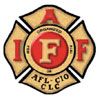 |
 |












